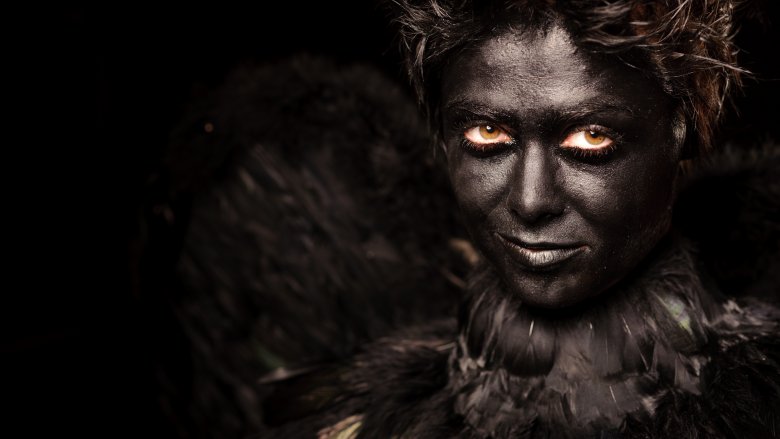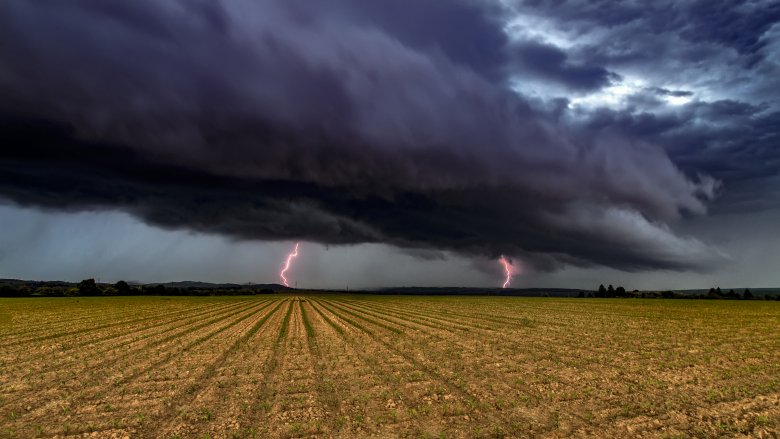Bizarre Things About The Weather Our Ancestors Believed
Every so often, Mother Nature takes the opportunity to remind us that no matter how many massive buildings we build, no matter how technologically advanced we are, and no matter how cool we think we are, we're still at her mercy. The normal wind and rain is just the start of it, and hardly a week goes by we don't hear about hurricanes, tornadoes, or tsunamis hitting somewhere in the world and bringing some serious devastation with them.
Today, scientists can predict some severe weather, but we still don't know how to stop it. Sometimes, the only thing to do is either batten down the hatches or get out of town, so just imagine what our ancestors thought when they saw the storm clouds rolling in. They didn't have all the technology we do today, so they needed to come up with their own explanations about what was happening in the skies above. Their stories might not tell us much about the weather, but they do say something very important: Our ancestors were weird people.
Someone disappears? The Harpies got them
Wind is the literal worst. There's nothing you can do against the wind, and it's essentially an invisible bully that can do a ton of damage. For the ancient Greeks, the strongest of winds were actually Harpyiai (harpies) — half-bird, half-woman creatures sent by Zeus to deliver an unmistakable message.
There are a few stories about the harpies delivering vengeance to particular people. After King Phineus of Thrace spilled some secrets, the harpies descended to steal every plate of food he tried to eat. It wasn't until the Argonauts visited and other wind gods — the Boreades — chased the harpies away that the king was left in peace. Not everything they did was bad, and Homer credits one with giving birth to the mystical horses of Achilles.
But ... most of what they did was bad. Greek lore said that when someone disappeared suddenly and completely, they had been stolen by the storm winds of the harpies. Typically it was thought the harpies then delivered their captives off to become slaves to the other gods.
The most disgusting forecast ever
The Victorians were obsessed with leeches. They thought almost any ailment could be cured by a generous application of leeches, and as if that wasn't bad enough, there was also a belief that leeches could give decent weather forecasts.
To be fair, they probably weren't any worse than the other methods of the day, but they were more gross. The movement really got into full swing when George Merryweather found an old poem that talked about a leech's tendency to rise to the surface when "disturbed." That led him to create the Tempest Prognosticator, which was essentially a fancy way of arranging 12 bottles containing leeches and water. When the air pressure dropped, the theory went, the leeches would rise in their bottles, trip a pin, and ring a bell.
Legit? Slightly, says Atlas Obscura. Merryweather would write the Whitby Philosophical Society whenever his leeches predicted a storm, and sometimes, they were right. Kind of. They were able to predict a storm was coming sometime in the future, but at the end of the day, that's not entirely helpful. Merryweather had grand plans for installing his Tempest Prognosticators all across London, but it wasn't long before the British Meteorological Office came up with some less gross options.
The Hag of Beara and the winter months
In Scotland and Ireland, the long, dark winter months were the domain of one of the mother goddesses. Sometimes she's known as Beira, Queen of Winter, and in other places, she's the less respectful Hag of Beara.
According to Irish traditions (via Wilderness Ireland), she was reborn every year on Samhain and grew more powerful throughout the winter months. On May 1 — Bealtine — she began to age until she became the Hag of Beara again. Traditional also says that on February 1, you could tell how long the winter was going to last. If it was a dark, overcast day, the Hag was sleeping and winter would end soon. If it was sunny, it was going to be a longer winter because she was up and burning her fires.
The Scottish tales of Beira are a little different. According to Wonder Tales from Scottish Myth and Legend (via Sacred Texts), Beira aged as summer approached and used all her power to prolong the winter with storms and frost even into the spring months. Finally, she headed off to the Green Island of the West, and on the last night of winter she would drink from the island's Well of Youth. Her youth restored, she headed back to Scotland and slept the summer away as a beautiful maid. By midsummer, she was an adult, by autumn she was elderly, and when winter returned, she returned to her haglike and horrible appearance.
The divine, uber-feminist rainbow
Zulu folklore has some incredible beliefs about the power of the rainbow, and they're documented in the book Zulu Thought-patterns and Symbolism.
They taught that at least one end of the rainbow always touched the ground and water because that's where the divine snakes, born from the rainbow, live. Any pool of water a rainbow touches was believed to be home to these snakes, which had the power to swallow a man whole. If a woman approached the pool, though, she could politely petition the divine Princess through the rainbow, and ask for whatever it was she wanted most. Childless women in particular were told to ask the rainbow for help conceiving, and — somewhat less heartwarming — ugly girls were told to watch for the rainbow so they could ask to be made pretty.
Men and boys were also told to be aware of the rainbow and not walk beneath it. Rainbows were thought to be responsible for bringing an incurable illness to any man unfortunate enough to walk near one.
The saint that brings the rains in England
St. Swithun is the patron saint of Winchester Cathedral and, like many saints, his story is a mixture of history and legend. He was a real person who was born around 800, and he was a counselor to kings until his death in 863.
According to Historic UK, his dying wish was to be buried outside beneath the rains. And he was for a while, but in 971 the Bishop of Winchester decreed that he should have a burial more befitting his life's work and status as patron saint. He was moved inside, and this is where the legend starts. After he was interred, the entire area was stricken by 40 days of storms as he expressed his heavenly displeasure. From then on, if it rained on St. Swithun's Day (July 15), it was said to be a sign it was going to rain for the next 40 days.
There's at least one massive, St. Swithun's Day storm on record, and it happened in 1315. But unfortunately, the story of the 40-day rainstorm beginning when his bones were first moved actually stems from a medieval mistranslation of old texts. So for centuries, people looked to the skies on St. Swithun's Day because some medieval scribe or translator goofed up.
The Ice Saints
Historic UK says many people believed church saints held some power over the weather, particularly over the areas and days they were most strongly associated with. St. Godelieve was thought to influence the weather in Flanders on July 6, while St. Medard, St. Gervase, and St. Protais flexed their stormy muscles in France on June 18 and 19.
The faithful in the Netherlands, Switzerland, Austria, Hungary, Germany, and Poland believed in the power of the Ice Saints, a group of bishops and martyrs who had feast days in mid-May. Just who makes up the group varies; it always includes St. Mamertus, St. Pancras, and St. Servatius (May 11, 12, and 13), and Poland typically includes St. Boniface (May 14). There's also occasionally St. Sophia, who has her feast day on May 15 and is sometimes called Cold Sophia.
According to the book Holy Holidays, the ice saints ushered in a period of freezing temperatures. Living in Germany says they're commonly called the cold gardeners or the icy men, and they're responsible for a cold snap called Eisheiligen. It's only after their feast days pass that the weather is guaranteed to be stable enough for planting crops, and in Germany, they're also said to be behind chilly nights in June, known as the Iron Nights.
The power to summon the winds and storm
Throughout history, people rumored to be able to summon and control winds and storms. Sir James George Frazer wrote about some in The Golden Bough (via Sacred Texts), and it's a fascinating fixation mankind has always had with storms.
In Greenland, women who were pregnant or who had just given birth were thought to be able to cause a storm by going outside, taking a mouthful of air, going back into the house, and exhaling. Finnish wizards were known to sell the wind — more precisely, they sold ropes tied in three knots. Untying the first knot would summon a moderate wind, the second knot would summon hard winds, and the third knot would summon a hurricane. That particular belief was so powerful that neighboring Estonians held Finnish wizards in high regard. Scottish witches summoned the wind by hitting a wet rag against a rock three times and reciting a chant, while the people of New Guinea believed it was the natives of Bibili who could summon the wind with a huff.
There were ways to stop the wind, too. The Khoikhoi could stop gusts of winds by hanging up skins, which would knock the wind to the ground when they were blown down. Ancient Corinthians wrote about a family said to know how to calm even the most vicious of storms, while in Sumatra, villagers besieged by storms would slash at the wind with swords to send it away.
The crop thieves of the sky-people
One of the most bizarre weather tales was told by the most unlikely of people: Saint Agobard of Lyon. He was born in the late eighth century, and most of his writings were of the typical religious and political bent. But according to The Cambridge History of Magic and Witchcraft in the West, he also wrote about wizards called the tempestarii. It was a long-held belief that they had the power to cause thunderstorms and hail, but when Agobard recorded them he suggests they were probably just men and women who dabbled in old pagan beliefs.
In 815, he wrote "On Hail and Thunder," an essay that describes the popular belief that these weather-controlling wizards were working hand-in-hand with sky people from a place called Magonia. It was a widespread belief that the sky sailors paid the weather wizards to call storms and damage crops, which were then loaded onto the sky ships and taken home. Agobard calls it "so much foolishness," but also adds it was so accepted that he had seen people taken prisoner, chained, and interrogated by villagers convinced they'd captured thieves from Magonia.
Some have taken Agobard's writing to be more than just a commentary on the weather, and scholar Jason Colavito says it's been interpreted as one of the earliest records of UFO sightings. Either way, it's a pretty epic story.
Here, boy! Here, wind! Come 'ere!
The ocean is a scary place, even by modern standards. Imagine sailing across it on a few pieces of wood nailed together, and it's easy to see why sailors would want to come up with stories and superstitions that might give them some agency in the face of a giant piece of Mother Nature they really had no control over.
A sailor might be tempted to whistle away a jaunty tune, but according to Melville's Folk Roots, there were a series of guidelines built around whether someone should whistle. Whistling was thought to call the wind, and in cases of calm skies and seas, sailors might whistle in hopes of raising winds and getting on their way. But they needed to be careful, because sudden winds were thought to herald the Devil. If whistling brought a strong gust, they were certain the Devil was now on board. Even worse, he was probably there because the whistling had made him insanely angry, and no one wants to deal with an angry devil — especially surrounded by the nothingness of the sea.
That's definitely not a pot of gold at the end of that one
Rainbows are one of nature's most beautiful weather wonders, but for the Karens of Burma, they were something very, very different. According to their lore (via The Karen People of Burma: A Study in Anthropology and Ethnology), there are a few different versions of the story, but a common one is that rainbows in the western sky were actually the spirit of Hades, setting up funerals for his children. More than that, it was a reminder of the importance of a proper burial, as neglecting the dead would bring tragedy to a family. Those foolish enough to point at a rainbow like this one had better stick their fingers in their belly buttons or risk bringing disaster into their lives.
So western rainbows were harbingers of tragedy, but eastern rainbows were just as heartbreaking. Women who died while pregnant were thought to be forever separated from the earth, the sky, and their loved ones, and their only way of quenching their thirst was through a rainbow. On the rare occasions when a double rainbow was seen in the east, it was said to be the spirit of the woman's husband visiting her.










